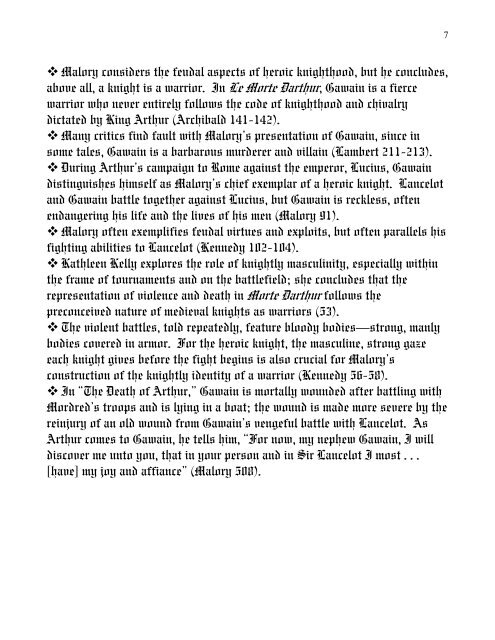A True Knight - Arthuriana
A True Knight - Arthuriana
A True Knight - Arthuriana
Create successful ePaper yourself
Turn your PDF publications into a flip-book with our unique Google optimized e-Paper software.
Malory considers the feudal aspects of heroic knighthood, but he concludes,<br />
above all, a knight is a warrior. In Le Morte Darthur, Gawain is a fierce<br />
warrior who never entirely follows the code of knighthood and chivalry<br />
dictated by King Arthur (Archibald 141-142).<br />
Many critics find fault with Malory’s presentation of Gawain, since in<br />
some tales, Gawain is a barbarous murderer and villain (Lambert 211-213).<br />
During Arthur’s campaign to Rome against the emperor, Lucius, Gawain<br />
distinguishes himself as Malory’s chief exemplar of a heroic knight. Lancelot<br />
and Gawain battle together against Lucius, but Gawain is reckless, often<br />
endangering his life and the lives of his men (Malory 91).<br />
Malory often exemplifies feudal virtues and exploits, but often parallels his<br />
fighting abilities to Lancelot (Kennedy 102-104).<br />
Kathleen Kelly explores the role of knightly masculinity, especially within<br />
the frame of tournaments and on the battlefield; she concludes that the<br />
representation of violence and death in Morte Darthur follows the<br />
preconceived nature of medieval knights as warriors (53).<br />
The violent battles, told repeatedly, feature bloody bodies—strong, manly<br />
bodies covered in armor. For the heroic knight, the masculine, strong gaze<br />
each knight gives before the fight begins is also crucial for Malory’s<br />
construction of the knightly identity of a warrior (Kennedy 56-58).<br />
In “The Death of Arthur,” Gawain is mortally wounded after battling with<br />
Mordred’s troops and is lying in a boat; the wound is made more severe by the<br />
reinjury of an old wound from Gawain’s vengeful battle with Lancelot. As<br />
Arthur comes to Gawain, he tells him, “For now, my nephew Gawain, I will<br />
discover me unto you, that in your person and in Sir Lancelot I most . . .<br />
[have] my joy and affiance” (Malory 508).<br />
7


